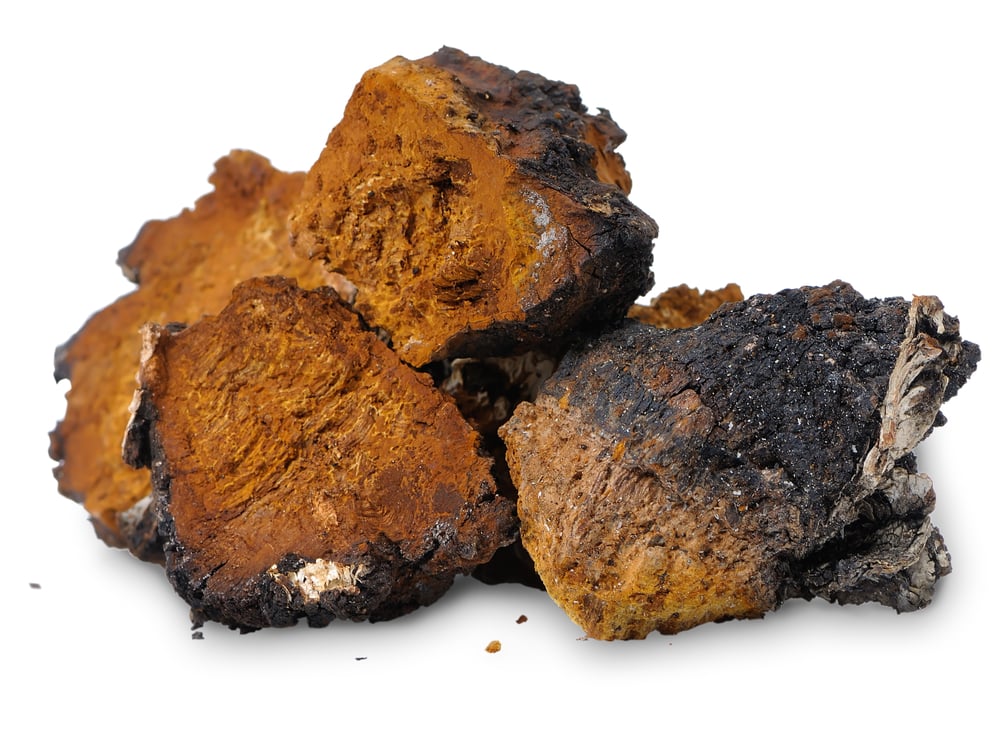Description by the therapist:
Chaga comes from Siberia and from the northern regions of China. Residents of Siberia have been brewing it since ancient times for cancer treatment and they call it the "Gift of God."
Chaga is used for various infectious diseases. Its effect is similar to Coriolus, which scans the body, searches for various pathogens and then eliminates them. Chaga’s effect is more focused on the digestive tract and the liver.
It works well with "hidden pathogens" (I described it in the Mushroom Collection under the Coriolus mushroom).
Thanks to its tropism, I use it for various intestinal problems and to support digestion. It is also used for constipation.
Chaga has healing effects and protects the gastric mucosa, both in the case of gastritis and ulcers. This effect is mainly attributed to betulinic acid.
It can both stimulate and dampen the immune system, which is excellent for various autoimmune problems. And thanks to tropism to the digestive tract, it is used as a complementary treatment for Crohn’s disease or ulcerative colitis.
Like Coriolus, it has a pronounced anti-cancer effect. It is mainly used for intestinal and liver cancer.
It can protect the liver and also regenerate it. It is used for cases of hepatitis.
Thanks to its tropism to the heart, it can harmonize the spirit Shen, supports mental functions, memory and concentration.
Its effect looks somewhat as if we combined Coriolus and Hericium.
I also need to point out that Chaga is an excellent antioxidant and adaptogen. It helps slow down cell aging and creates resistance of the body to the external environment.
Uses tested in practice:
- activation of the immune system in case of bacterial and viral infection + Coriolus, ABM, Reishi, Maitake
- cholesterol and blood pressure regulation + Reishi, Maitake, Auricularia
- supports the cardiovascular system
- supports and cleanses the intestines + Hericium
- anti-inflammatory effects + Reishi
- complementary therapy of tumours and tumour prevention + according to tumour type
Other motives for the use of Chaga:
support for diabetes, analgesic effects (relieves pain), hepatoprotective effects (protection of the liver), support of mental functions - memory, concentration, thinking (inhibits enzyme acetylcholinesterase in the brain), detoxification, strong antioxidant action, digestive support, gastritis, stomach or duodenal ulcers, support when doing sports (with Coriolus and Cordyceps), Crohn's disease, ulcerative colitis, eczemas, psoriasis, cleansing of blood, leukaemia, malaria, supports eyes and hair, it is probably the most powerful adaptogen, antiaging effects, anti-allergic action (anaphylactic shock prevention), herpes zoster (shingles), candidiasis, hepatitis C, infectious diseases, whether bacterial or viral, even in the case of herpes viruses
TCM characteristics:
- temperature – warm
- taste – sweet
- tropism – liver, spleen, heart (kidneys, stomach)
Effects according to traditional Chinese medicine:
- nourishes liver, kidneys and heart
- transforms mucus
- revives blood
- calms the mind, supports defensive qi
Brief description
Chaga (Inonotus obliguus, rezavec šikmý, birch mushroom, tschagapilz, Hua Jie Kong Jun) is a wood-decaying mushroom. It lives for several years and produces two kinds of sporocarps, sexual and non-sexual. After attacking a tree, it creates dark, dark-black "cracked" sporocarps, which include chlamydospores, i.e. spores. These sporocarps can survive for several years and have a size of about 10-35 cm. Later, when the mushroom is ripening and the infected tree is dying, as the mushroom has spread through the tree trunk, the second type of sporocarps is formed, which includes sexual spores - basidiospores. These sporocarps are bigger and can reach even a few meters. Chaga is parasitic mainly on deciduous trees, most often found on birch, from which we also gain the important component of betulin, with broad therapeutic effects.
Chaga is widespread in the northern hemisphere. It is well known in Russia, where it is also part of traditional Russian medicine. However, it is also known in traditional Chinese medicine.
The mushroom has been known since about 4000 years ago, used by the Mesopotamians, Egyptians, Chinese, etc. Chaga is also described in the Chinese “herbarium” Shen Nong Ben Cao Jing. In Russia and Siberia, it was used both for healing and shamanic rituals, especially by the Khanty/Oystak people, who also gave it the name most commonly used today. Chaga was also enjoyed by the tsar Vladimir Monomach and Rasputin... It was also mentioned by Solzhenitsyn in his book Cancer. Moreover, Chaga was not unknown to the original inhabitants of Japan, i.e. the Ainu. They brewed tea from it, which they drank for digestive problems, stomach pains, etc. And they used powder from the dried mushroom for religious ceremonies.
Chaga was also known to Native Americans in North America.
In modern history, Chaga has been studied since 1864 by J. G. N Dragendorff in St. Louis. Peterburg. Significant progress was made in exploring the mushroom in the 20th century, when its composition was revealed and the research of its effects began.
Conclusion
There is probably no doubt that Chaga is beneficial to our health, either as a "cure" or as a prevention of many diseases. It harmonizes the immune system, protects and regenerates organs, slows down aging ... It affects the body as a whole, which most chemical drugs cannot do, as they often solve only one problem.




